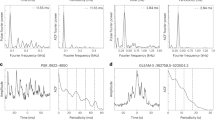Abstract
RADIO astronomers1–3 have recently discovered pulsars in Vela and near the Crab nebula which seem to be associated with supernova remnants and have repetition periods (0.0892 s and 0.0331 s) considerably shorter than those previously found. The very wide range (60-fold) of periods at present observed is difficult to understand if pulsars are in fact pulsating objects of a single class, because in general (period) ∝ (density)−1/2 and an extremely wide range of density would be required. Of the remaining clock mechanisms proposed, rotation4,5 seems most consistent with the observations. The extremely short periods exclude white dwarfs and make the suggestion of neutron stars more likely.
This is a preview of subscription content, access via your institution
Access options
Subscribe to this journal
Receive 51 print issues and online access
$199.00 per year
only $3.90 per issue
Buy this article
- Purchase on Springer Link
- Instant access to full article PDF
Prices may be subject to local taxes which are calculated during checkout
Similar content being viewed by others
References
Large, M. I., Vaughan, A. E., and Mills, B. Y., Nature, 220, 340 (1968).
Staelin, D. H., and Reifenstein, E. C., Science (in the press).
Lovelace, R. B. E., Sutton, J. M., and Craft, H. D., IAU Telegram Circular No. 2113 (1968).
Ostriker, J. P., Nature, 217, 1227 (1968).
Gold, T., Nature, 218, 731 (1968).
Pacini, F., Nature, 219, 145 (1968).
Landau, L., and Lifshitz, L., The Classical Theory of Fields (Addison Wesley, 1951).
Richards, D., IAU Telegram Circular No. 2114 (1968).
Hartle, J., and Thorne, K., Ap. J., 153, 807 (1968).
Hayme, R. C., Ellis, D. V., Fishman, G. J., Kurfoss, J. D., and Tucker, W. H., Ap. J., 151, L9 (1968).
Wheeler, J., Ann. Rev. Astro. Astrophys., 4, 423 (1966).
Woltjer, L., Bull. Astro. Inst. Neth., 14 (1958).
Scargle, J., Ap. J. (in the press).
Hewish, A., Bell, S. J., Pilkington, J. D., Scott, P. F., and Collins, R. A., Nature, 217, 709 (1968).
Harris, D. E., Ap. J., 135, 661 (1962).
Layzer, D., Nature, 220, 247 (1968).
Eastlund, B. J., Nature, 220, 1293 (1968).
Author information
Authors and Affiliations
Rights and permissions
About this article
Cite this article
GUNN, J., OSTRIKER, J. Magnetic Dipole Radiation from Pulsars. Nature 221, 454–456 (1969). https://doi.org/10.1038/221454a0
Received:
Issue Date:
DOI: https://doi.org/10.1038/221454a0
This article is cited by
-
Strong toroidal magnetic fields required by quiescent X-ray emission of magnetars
Nature Astronomy (2020)
-
Novel astrophysical probes of light millicharged fermions through Schwinger pair production
Journal of High Energy Physics (2019)
-
Pulsar braking: magnetodipole vs. wind
Science China Physics, Mechanics & Astronomy (2016)
-
Magnetic Fields of Neutron Stars in X-Ray Binaries
Space Science Reviews (2015)
-
Plasma magnetosphere and spin down of rotating magnetized strange stars in general relativity
Astrophysics and Space Science (2013)
Comments
By submitting a comment you agree to abide by our Terms and Community Guidelines. If you find something abusive or that does not comply with our terms or guidelines please flag it as inappropriate.



